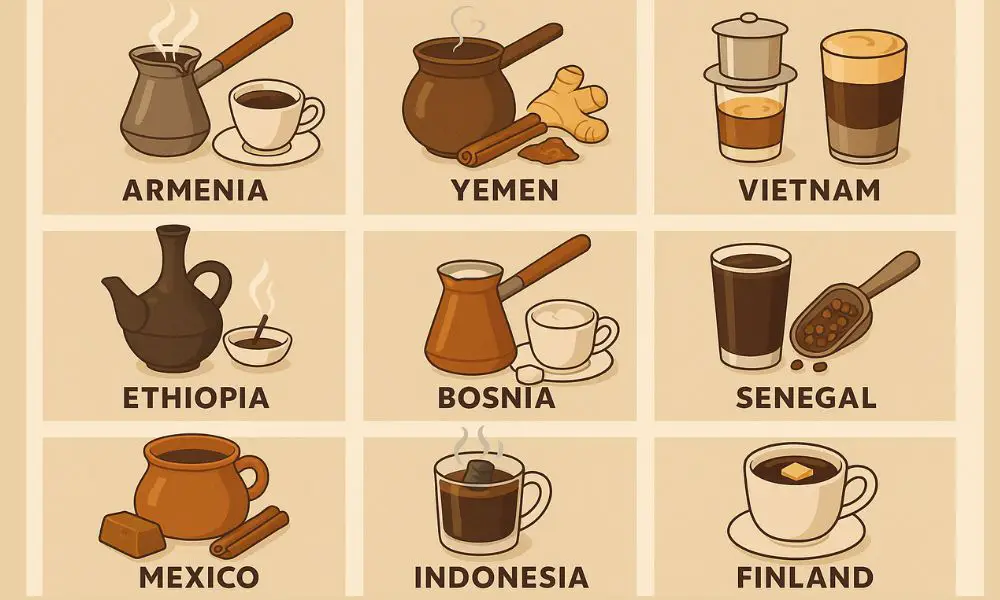
Coffee rituals carry memory, hospitality, and pace. Outside the café menu, many cups come with small rules and meanings that shift how you brew and how you sit with people. Here’s a tour of lesser-known traditions and simple ways to try them at home.
Armenia: soorj, the jazzve, and reading the cup

Armenian coffee is thick, powder-fine coffee simmered in a small pot called a jazzve and poured into tiny cups. It looks similar to Turkish or Greek coffee, yet the cadence in Armenian homes is its own: the host sets the pace, the foam signals care, and the tiny cup gives everyone a reason to sit. The brew is strong, often lightly sweet, and the texture invites slow sips rather than quick gulps.
After the last sip, the table turns into a small theater. You place the saucer over the cup, flip it away from your body, and let grounds slide and dry. Someone else reads patterns left inside: roads, birds, letters, a ring. The reading is part game, part permission to linger. It stretches conversation, gives shy guests an entry line, and turns a simple drink into a social anchor.
How to try it: Use an ibrik/jazzve or a tiny saucepan. Grind coffee to a talc-fine powder. Bring water just to a simmer, stir in coffee (and sugar if you like), let it rise, pull it off heat before a full boil, and pour. Leave the last sip, flip, wait a minute, and trade cups for the reading.
Yemen: qishr and the spirit of Mocha

In Yemen, the most shared “coffee” at home isn’t roasted beans. It’s qishr, a light, spiced brew made from coffee cherry husks simmered with ginger and often cinnamon. The drink sits between coffee and tea. It’s fragrant, bright, and far gentler on caffeine, which makes it well suited to long visits and late nights.
Qishr’s habits grew from thrift and flavor. Husks are a by-product of processing beans. Rather than toss them, families turned them into a daily pot that scents the house. The link to the old port of Mocha adds a thread of history to every cup. You taste spice first, then a gentle fruit note from the husk. It pairs well with dates or simple breads and works across seasons because it’s warming without weight.
How to try it: Buy cascara (coffee husk). Simmer a small handful in water with sliced ginger and a piece of cinnamon for 8–10 minutes. Sweeten to taste. Strain and serve in small glasses. Add a cardamom pod if you want more lift.
Vietnam: the phin, egg coffee, and salted coffee
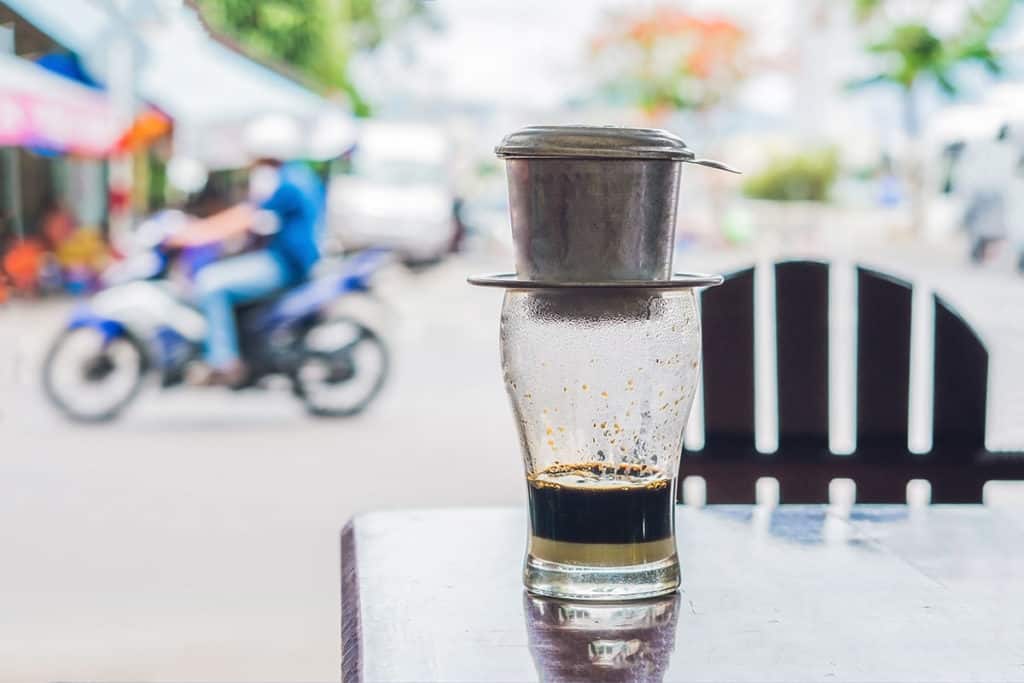
Vietnamese daily coffee centers on the phin, a small metal filter that sits right on the cup. The slow drip turns making coffee into a pause rather than a chore. Robusta is common, so the resulting brew is thick, bold, and slightly chocolaty. With ice and condensed milk, you get a strong, sweet hit that carries you through the humid afternoon.
Two modern icons add texture to this base. Egg coffee from Hanoi tops a small, strong cup with a rich foam made from egg yolk and condensed milk. It drinks like a coffee dessert, warm and custardy. Salt coffee, which rose in Hue and spread widely, uses a pinch of salt in lightly whipped cream or salted milk. The salt softens bitterness and sharpens sweetness, so flavors feel round and balanced. Both grew from practical needs and local taste but now stand as signatures that travelers hunt down.
How to try it: For phin coffee, add medium-fine grounds to the phin, tamp gently, pour a splash of hot water to bloom, then fill and let it drip into your cup. For egg coffee, whisk one yolk with condensed milk until glossy and thick, then float it over hot coffee. For salt coffee, whisk cream or milk with a tiny pinch of salt and a little sugar to a pourable thickness and layer it over iced coffee.
Ethiopia and Eritrea: three rounds from the jebena
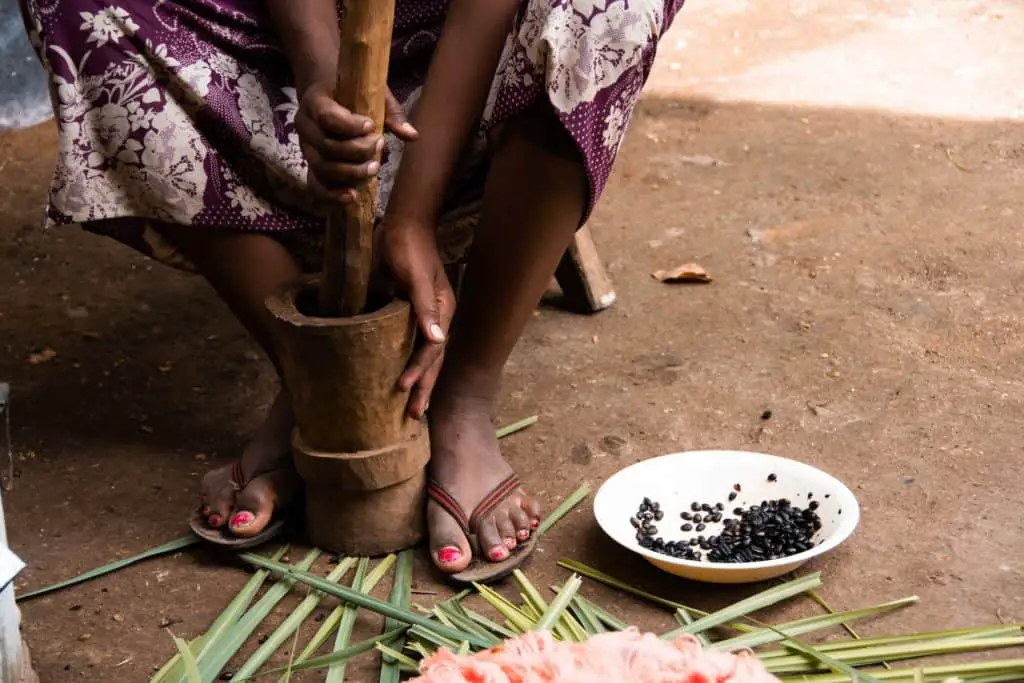
The coffee ceremony in Ethiopia and Eritrea is a full gathering, not a quick pour. Green beans are washed, roasted over coals, ground, and simmered in a clay pot called a jebena. Incense may burn. Grass or flowers can be set on the floor. Coffee is poured in three rounds—abol, tona, and baraka—each one a little lighter than the last. The series marks time together, conversation, and blessing.
The roles matter. The host, often the woman of the house, handles the roast, the grind, and the pour. Guests show respect by accepting all three rounds. Snacks like popcorn or roasted barley sit within reach, and the steady stream of small cups keeps everyone tuned to the same pace. The ceremony can mark visits, holidays, or simply an afternoon, but the message is steady: sit, talk, and stay present.
How to try it: If you have a jebena, heat water to a simmer, add fresh grounds, and keep the pour smooth into small cups. No jebena? Brew a fresh, aromatic pot and serve three small rounds with something to nibble, leaving phones elsewhere. The repeated pours are the point.
Bosnia and Herzegovina: foam first and time on the table
Bosnian coffee uses a copper džezva and an ultra-fine grind, yet the service sets it apart. The host spoons foam into each fildžan (small cup) before pouring the liquid. Water arrives on the side. A bite of lokum or a single sugar cube may sit on the saucer. You don’t stir. You sip in small takes and talk.
The no-stir rule protects the clean layer on top and keeps grounds settled. It also nudges you to slow down. The sequence—water first to clear the palate, foam to open aroma, sips without rush—builds a rhythm. It turns a table into a place for news, family updates, and quiet jokes. The cup size helps; small volume means more refills and more moments to pause.
How to try it: Heat water in a džezva, pull from heat, stir in powder-fine coffee, return just to the rise, then settle. Spoon foam into cups, top with coffee, and set a glass of water beside each cup. Leave the spoon out of it. Let the grounds rest and the talk take over.
Senegal: Café Touba and Sufi roots
Café Touba is spiced coffee linked with the Mouride Sufi brotherhood and named for the holy city of Touba. Vendors roast grains of Selim (Guinea pepper) with coffee, sometimes with a touch of clove, then grind and brew a sweet, pepper-warm cup. It is sold on streets and poured at home, tied to prayer, community events, and daily routines.
The spice does more than add heat. It brings a dry, aromatic finish that makes the cup taste almost herbal. Sweetness meets a gentle prickle, and the combination works well in hot weather because the spice clears the palate. The method is flexible—drip, cloth filter, or simple boil—and that makes it portable. You see thermoses at markets and office doors, not just cafés.
How to try it: If you can source grains of Selim, crush a small piece and grind it with your coffee. Add a clove or two if you like. Brew as a pour-over or strong filter. Sweeten more than you think you need; the spice balances it.
Finland and Swedish Lapland: kaffeost, coffee with cheese
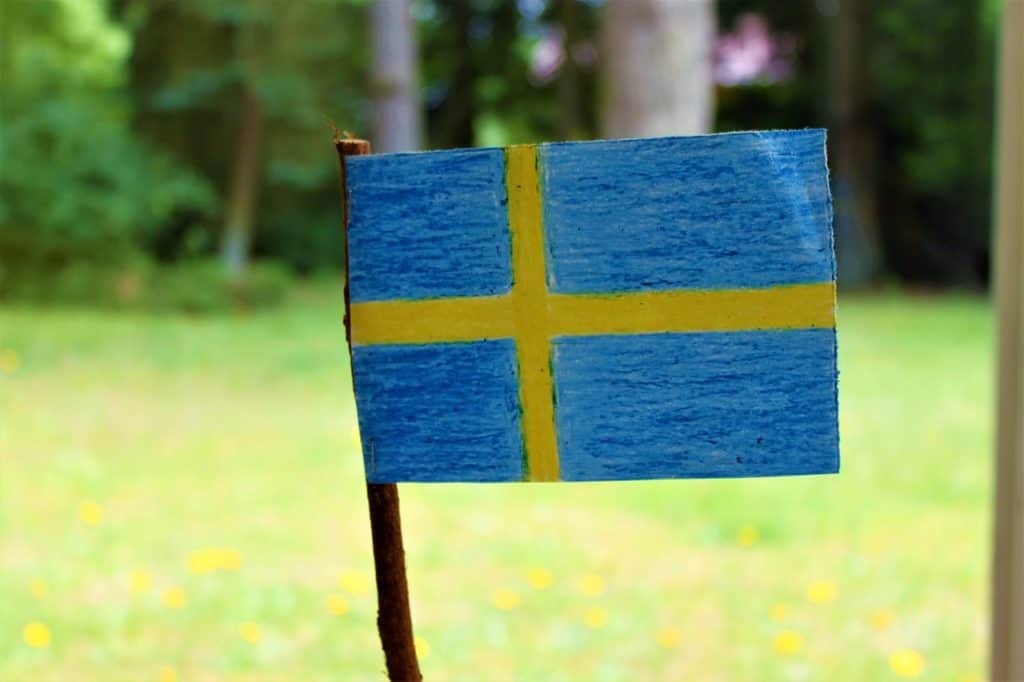
In the far north, people drop cubes of juustoleipä (bread cheese) into a cup and pour hot coffee over them. The cheese softens, soaks up coffee, and turns each spoonful into a warm, chewy bite. It is winter-friendly comfort and a smart way to add calories when days are long and cold.
The texture is the joy here. The cheese squeaks a little, stays intact, and gives a buttery note to the coffee. Families often warm the cheese first to wake up its dairy sweetness, then pour. The cup becomes a bowl by the end. You can sip, then eat the softened cubes, or alternate. It fits slow mornings, ski returns, and late-night chats when you don’t want dessert but want something that feels like it.
How to try it: Warm leipäjuusto cubes in your cup, then add fresh hot coffee. Spoon out a cube between sips. If you prefer less chew, cut smaller cubes so they soften faster.
Indonesia (Yogyakarta): kopi joss with live charcoal
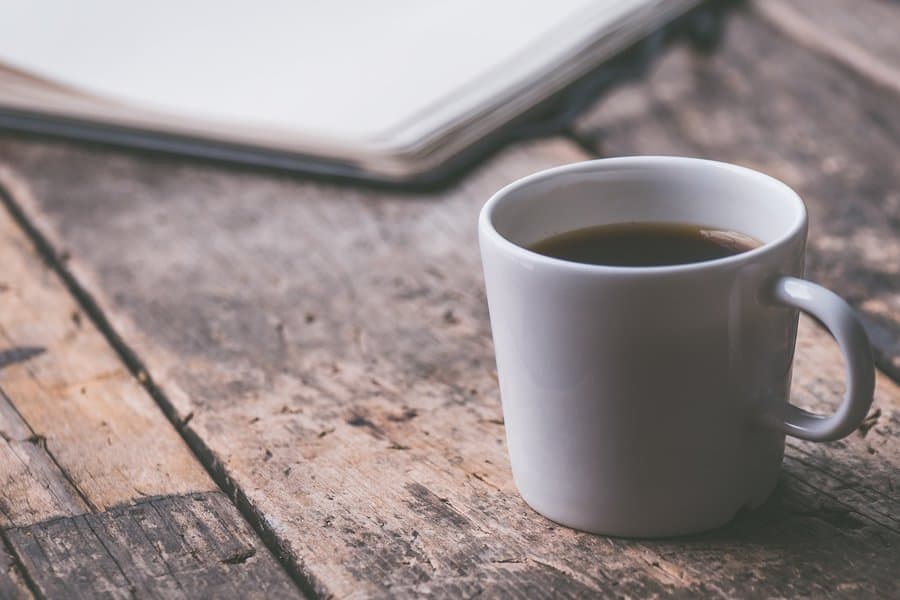
Kopi joss is a street-stall show. A vendor pours sweet black coffee, then drops in a small piece of red-hot charcoal. It hisses, smokes for a moment, and cools in the cup. The coal is fished out or left to rest while you drink. People describe the flavor as smoother, with a caramel edge and a light smoke scent.
As a ritual, it’s an evening magnet. Stalls line up near train tracks and night markets, and the sound of hot charcoal hitting liquid gets attention. Friends gather, share snacks, and take photos. It’s dramatic, yet the cup itself is simple. The experience, setting, and friends do the real work. If you love the idea but not the coal, you can chase the same mood with a roast that leans smoky and a seat outdoors at dusk.
How to try it: Don’t drop random charcoal into drinks at home. Instead, brew a slightly darker roast and add a small spoon of raw sugar to echo the street-stall sweetness. Drink outside in the evening. The setting is half the flavor.
Mexico: café de olla in clay
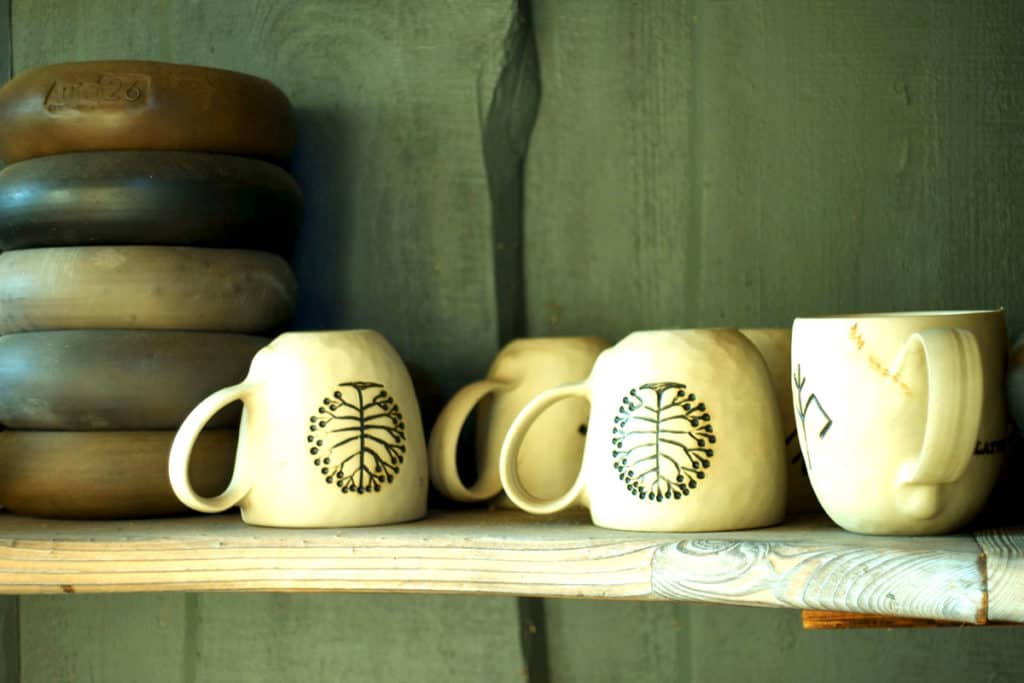
Café de olla simmers coffee with piloncillo (unrefined cane sugar) and canela (Mexican cinnamon) in a clay pot. The porous clay lends a faint earthy note, and the spice-sugar mix wraps the coffee in warmth. The drink shows up in mountain towns, markets, and cold mornings, and it holds a place in family kitchens where a pot can sit on low heat for refills.
Stories tie the drink to camp kitchens during the Revolution, yet its pull now is everyday comfort. It is forgiving to brew, easy to scale for groups, and friendly with food. Fresh tortillas, tamales, pan dulce—everything seems to pair. Because the spice leads, you can use modest beans and still end up with a cup that feels generous.
How to try it: Break a cone of piloncillo into a pot with water and a stick of canela. Simmer until dissolved. Pull from heat, stir in ground coffee, steep a few minutes, strain, and pour. Clay is nice, not required.
Midwest “egg coffee”: clear pots for big tables
In Swedish-American church basements across the Upper Midwest, egg coffee still appears at gatherings. A beaten egg binds with grounds in boiling water, clarifying the brew. After a few minutes, a splash of cold water helps settle the mass to the bottom. The resulting coffee is light in body, clear in the cup, and easy to pour by the gallon.
The method fits its setting. You can brew for a crowd with cheap gear, keep the pot hot for an hour, and serve clean cups without a fancy filter. The flavor is gentle, which means cakes and casseroles can take center stage. You also avoid the sludge that comes with giant percolators. It’s a practical, almost engineer-like answer to “How do we serve coffee to 200 people without fuss?”
How to try it: For a small batch, whisk one egg into the dry grounds, stir into a pot of simmering water for a few minutes, then add a splash of cold water to settle. Pour off the clear coffee slowly. Expect delicate flavor and a bright finish.
Quick reference: gear, flavors, and ways to try
| Tradition | Core gear | Flavor markers | At-home path |
|---|---|---|---|
| Armenia (soorj + cup reading) | Jazzve/ibrik | Dense, cocoa-bitter, possible sugar | Powder-fine grind, brief simmer, foam on top, flip and read. |
| Yemen (qishr) | Pot, no filter | Ginger spice, light body, tea-like | Simmer husks with ginger and cinnamon, sweeten, strain. |
| Vietnam (phin, egg, salt) | Phin; whisk | Syrupy robusta; custard-like foam; balanced salted cream | Drip with phin, add egg foam or salted cream. |
| Ethiopia/Eritrea (jebena ceremony) | Jebena | Roasty, aromatic, three rounds | Roast if possible, brew, and pour three small rounds with snacks. |
| Bosnia | Džezva, fildžan | Thick body, foam-first, no stirring | Spoon foam, pour, serve with water and lokum. |
| Senegal (café Touba) | Grinder + filter | Sweet heat, pepper-clove aroma | Grind with grains of Selim, brew strong, sweeten. |
| Finland/Swedish Lapland (kaffeost) | Cup + juustoleipä | Savory-sweet, buttery finish | Warm cheese cubes, add hot coffee, spoon between sips. |
| Indonesia (kopi joss) | Glass + tongs | Sweet black coffee, hint of smoke | Skip the coal at home; use a darker roast and raw sugar. |
| Mexico (café de olla) | Clay pot | Piloncillo-sweet, cinnamon-warm | Simmer sugar and canela, steep coffee, strain. |
| Midwest “egg coffee” | Pot, egg | Clear, light, low fines | Egg-clarify, settle with cold water, decant. |
Final notes for curious brewers
Before you pick a method, pick a goal. Do you want a cup that slows everyone at the table, a flavor you haven’t tasted yet, or a simple way to host a crowd? Each tradition above solves one of those problems with different gear and rules. Start with the outcome you want, then choose the smallest change that gets you there.
- Grinding and heat control. Unfiltered stovetop methods (jazzve/džezva, jebena) depend on powder-fine grinds and tight heat. The foam and texture are the payoff. Use a burr grinder that can go ultra-fine and pull your pot before a rolling boil.
- Spice and balance. Ginger in qishr or grains of Selim in café Touba aren’t decoration. They change structure. If sweetness jumps, add a tiny pinch of salt. If spice leads, raise sweetness a notch. Aim for a finish that invites another sip.
- Ritual over recipe. The small rules matter because they set tempo. Three Ethiopian rounds, a Bosnian no-stir cup, or a phin dripping at your desk each creates a pocket of time. Keep phones away, pour small, and let the ritual do its job.
- Match the crowd. Egg coffee charms a short table and makes dessert redundant. Egg-clarified coffee serves a hall without sludge. Café de olla pairs with food. Kaffeost comforts on cold days. Choose by setting, not by trend.
- Gear you actually use. A phin, a small ibrik, and a clay pot cover most of these. They are cheap, compact, and hard to break. If a tool lives in a drawer, you won’t reach for it. Keep the one you’ll grab at 7 a.m.
- Source with intent. Robusta shines in phin brews. Medium-dark roasts carry spice in café Touba and café de olla. Lighter, aromatic roasts sing in jebena rounds. Husks for qishr need to smell clean and fruity, not musty.
Pick one tradition this week and make it part of your routine. Brew small. Serve with intention. Let the cup set the pace.
